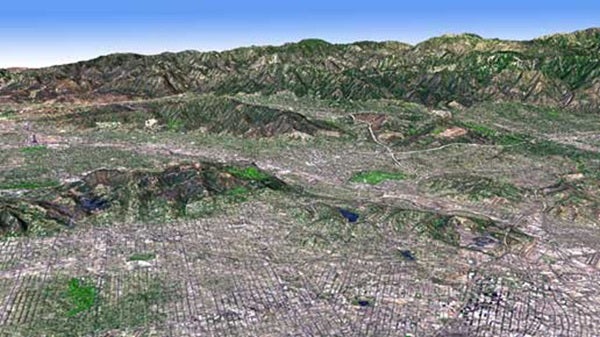NASA and Japan released a new digital topographic map of Earth June 29 that covers more of our planet than ever before. The map was produced with detailed measurements from NASA’s Terra spacecraft.
The new global digital elevation model of Earth was created from nearly 1.3 million individual stereo-pair images collected by the Japanese Advanced Spaceborne Thermal Emission and Reflection Radiometer (ASTER) instrument aboard Terra. NASA and Japan’s Ministry of Economy, Trade and Industry (METI) developed the data set. It is available online to users everywhere at no cost.
“This is the most complete, consistent global digital elevation data yet made available to the world,” said Woody Turner, ASTER program scientist at NASA Headquarters in Washington. “This unique global set of data will serve users and researchers from a wide array of disciplines that need elevation and terrain information.”
According to Mike Abrams, ASTER science team leader at NASA’s Jet Propulsion Laboratory (JPL) in Pasadena, California, the new topographic information will be of value throughout the Earth sciences and has many practical applications. “ASTER’s accurate topographic data will be used for engineering, energy exploration, conserving natural resources, environmental management, public works design, firefighting, recreation, geology, and city planning, to name just a few areas,” Abrams said.
Previously, the most complete topographic set of data publicly available was from NASA’s Shuttle Radar Topography Mission. That mission mapped 80 percent of Earth’s landmass, between 60° north latitude and 57° south. The new ASTER data expands coverage to 99 percent, from 83° north latitude and 83° south. Each elevation measurement point in the new data is 98 feet (30 meters) apart.
The ASTER data fill in many of the voids in the shuttle mission’s data, such as in very steep terrains and in some deserts,” said Michael Kobrick, Shuttle Radar Topography Mission project scientist at JPL. “NASA is working to combine the ASTER data with that of the Shuttle Radar Topography Mission and other sources to produce an even better global topographic map.”
NASA and METI are jointly contributing the ASTER topographic data to the Group on Earth Observations, an international partnership headquartered at the World Meteorological Organization in Geneva, Switzerland, for use in its Global Earth Observation System of Systems. This “system of systems” is a collaborative, international effort to share and integrate Earth observation data from many different instruments and systems to help monitor and forecast global environmental changes.
NASA, METI, and the U.S. Geological Survey validated the data, with support from the U.S. National Geospatial-Intelligence Agency and other collaborators. The data will be distributed by NASA’s Land Processes Distributed Active Archive Center at the U.S. Geological Survey’s Earth Resources Observation and Science Data Center in Sioux Falls, South Dakota, and by METI’s Earth Remote Sensing Data Analysis Center in Tokyo.
ASTER is one of five Earth-observing instruments launched on Terra December 1999. ASTER acquires images from the visible to the thermal infrared wavelength region, with spatial resolutions ranging from about 50 to 300 feet (15 to 91 meters). A joint science team from the U.S. and Japan validates and calibrates the instrument and data products.










